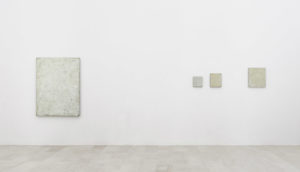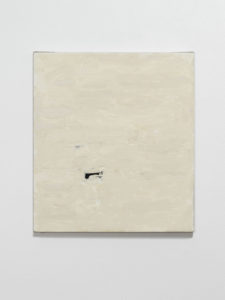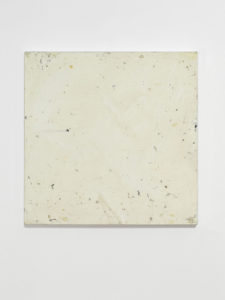Since the 1960s, the work of Stephen Rosenthal (Washington, D.C., United States, 1935) has been framed in an anarchic manner in the widespread current of abstract painting, born in that period as a decision to make painting exist in itself and without any external interference. The artist shares with his colleagues the need for critical introspection on the pictorial object free of images, feelings and historical tradition and the interest in a process based on the physical and tangible properties of the materials involved, but rejects the rigid syntax in which leads to the most orthodox (and celebrated) fringes of the movement. As underlined by an intense essay by Germano Celant, written in 1975 on the occasion of a solo exhibition by the artist at La Jolla Museum of Contemporary Art, Rosenthal’s intent is to re-establish the individuality of painting by restoring in its primary elements a varied range of accidental values and unrepeatable materials and emphasizing the complementarity between the pictorial layer and its support, valued as an active agent of creation.
In this way the painted surface is transformed into a space that affirms its environmental vocation generated by the traces of actions that progressively settle on each other. The concept of trace, intended both as a mark and as a residue, is at the center of the poetics of the American artist, who for nearly fifty years investigates the possibilities of reducing painting through the use of transparent films and colors applied to be subsequently erased by solvents, incisions and abrasions. The different stages of interaction between the materials (at the time of execution and over time due to their mutual adjustments) thus assume the value of plastic events and become instruments for documenting and revealing the vitality of painting. These signals, offered to the free interpretation of the spectator, then become the link between the internal reasons of painting and the imagination of the viewer, without having to go through the conceptual or narrative mediation of a pre-constituted image.
The P420 gallery in Bologna inaugurates its collaboration with Rosenthal with the exhibition Islands, Archipelagoes, Constellations. Works on canvas and paper 2006-2018, which presents the artist’s two most recent pictorial cycles, developed over the last fifteen years. Both series are the result of a stratification of actions that stabilize on the canvas according to a precise order, demonstrating in each work a different point of balance between the “putting” (the addition of color) and the “remove” (its partial cancellation with rags and solvents). With respect to the historical works it seems that the artist’s interest has shifted from the reflection on the ontological implications of the pictorial discipline to an existential meditation experienced through painting. The starting technical assumptions did not change much, nor did the idea of the canvas painted as a field of self-significant signs, but his approach radically changed, now focused on the concretization of an absence, on the fading of a perception, on the construction of a material intangibility. Or on fixing what by its nature is elusive, freeing it from the weight of permanence, on resisting inconsistency with lumps of discrete but tenacious matter, on observing time as a slow and ungraspable action.
The ideal focus of the exhibition is a sheet of notes written in pencil in which the artist saturates the space with the countless variations of his mantra in the form of words: deviate, expunge, dislocate, revoke, transpose, retract, repulse, disappear, wipe out, clean out, transport, confuse, delete, transpose, destroy, resituate, mislead, drop out, astound, confound, detour, resurface, get lost. It is as if every term was a nuance of a palette of mental suggestions that he translates onto the canvas as spots, smudges, afterthoughts, imprints, drops, rarefied brushstrokes of which only the pattern remains, graphite tip doodles lost in an abrasion, numbers drawn by hand. Doing painting for Rosenthal means falling and getting up until he finds peace, explore his hidden thoughts, suspend the visible in a state of latency to understand its structure and secret internal relations.
The first cycle of works, which recalls the Islands suggestion of the title, shows white covering brushstrokes from which traces of primer emerge (always white, but colder) and light traces mixed with pencil marks. The painting materializes a dense space modeled by the gesture that guides the brush, within which stands a circumscribed thickening of a contrasting color left exposed. We cannot know what lies beneath the thick superficial blanket and even if that half-submerged color float is only a small part of a larger outcrop that will come with time, but the assertiveness of its presence reminds us how sometimes the effort of removal ends up by intensifying what we would like to evade.
From the calm concentration of these first paintings we move on to the dusty dissemination of traces, ideally afferent to the terms Archipelagoes and Constellations, which characterizes the most recent drawings and paintings, exhibited in the second room. Here the white preparation is a thin layer that seems to drag in its movement small chromatic detritus that twirl like petals in a delicate dance. The space is multicentric, impossible to capture with a single glance and from a single angle and the tiny colored reliefs that dot it (or the pencil figures that sometimes appear) are signs and reference points that help the eye to get lost in the delicate sensitivity of Rosenthal.
Info:
Stephen Rosenthal. Islands, Archipelagoes, Constellations.
Works on canvas and paper 2006-2018
September 29 – November 3 2018
P420
Via Azzo Gardino 9 Bologna

Stephen Rosenthal, Islands, Archipelagoes, Constellations. Works on canvas and paper 2006-2018, installation view, 2018, Courtesy P420, Bologna Photo Credit Carlo Favero

Stephen Rosenthal, Ochre 506, 2007, olio su tela_oil on canvas, cm. 49,5×44,5 courtesy the artist and P420, Bologna Photo Credit Carlo Favero

Stephen Rosenthal, Painting 4.04, 2016, olio su tela_oil on canvas, cm. 63,5×63,5 (courtesy the artist and P420, Bologna Photo Credit Carlo Favero
Graduated in art history at DAMS in Bologna, city where she continued to live and work, she specialized in Siena with Enrico Crispolti. Curious and attentive to the becoming of the contemporary, she believes in the power of art to make life more interesting and she loves to explore its latest trends through dialogue with artists, curators and gallery owners. She considers writing a form of reasoning and analysis that reconstructs the connection between the artist’s creative path and the surrounding context.







NO COMMENT